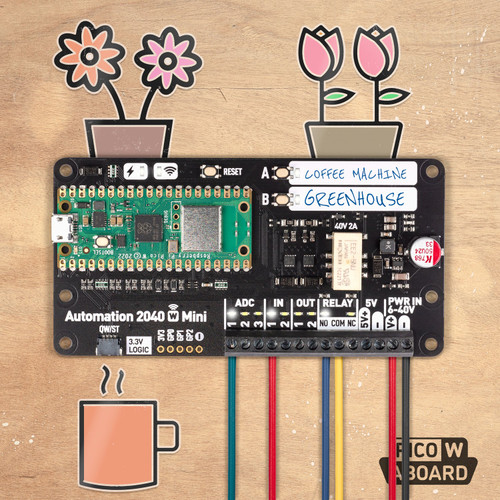

A slimline industrial/automation controller with 2.4GHz wireless, powered by Raspberry Pi Pico W. Compatible with 6V to 40V systems.
Automation 2040 W Mini is a compact Pico W / RP2040 powered monitoring and automation board. It has a host of useful features for controlling other bits of electronic and industrial kit - analog channels, powered outputs, buffered inputs and a relay. Perfect for controlling fans, pumps, solenoids, chunky motors, electronic locks or static LED lighting (up to 40V).
All the channels (and the buttons) have an associated indicator LED so you can see at a glance what's happening with your setup, or test your programs without having hardware connected. We've even left some space for labelling whatever you've got connected up, be it a hidden trap door for surprising your enemies, a coffee machine with an associated API, or a mechanism for dispensing tasty treats to your pets (or family) remotely.
Features
- Raspberry Pi Pico W Aboard
- Dual Arm Cortex M0+ running at up to 133Mhz with 264kB of SRAM
- 2MB of QSPI flash supporting XiP
- Powered and programmable by USB micro-B
- 2.4GHz wireless
- 3 x 12-bit ADC inputs up to 40V
- 2 x digital inputs up to 40V
- 2 x digital sourcing outputs at V+ (supply voltage)
- 4A max continuous current
- 2A max current at 500Hz PWM
- 1 x relay (NC and NO terminals)
- 2A up to 24V
- 1A up to 40V
- 3.5mm screw terminals for connecting inputs, outputs and external power
- 2 x tactile buttons with LED indicators
- Reset button
- 1 x Qw/ST connector for attaching breakouts
- M2.5 mounting holes
- Fully assembled
- No soldering required.
- C/C++ and MicroPython libraries
- Schematic
Power
- Board is compatible with 12V, 24V and 36V systems
- Requires supply 6-40V
- Can provide 5V up to 0.5A for lower voltage applications
Software
The C++/MicroPython libraries provide a straightforward way to interface with the functions on this board. You'll get best performance using C++, but if you're a beginner we'd recommend using our batteries included MicroPython build for ease of getting started.
- Download pirate-brand MicroPython (you'll need the `picow` .uf2)
- Getting Started with Raspberry Pi Pico
- MicroPython examples
- MicroPython function reference
- C++ examples
- C++ function reference
Check out our Getting Started tutorial for a walkthrough of Automation features and functions and how to program it using MicroPython.
Connecting Breakouts
The Qw/ST connector on Automation 2040 W Mini makes it super easy to connect up Qwiic or STEMMA QT breakouts. If your breakout has a QW/ST connector on board, you can plug it straight in with a JST-SH to JST-SH cable.
Breakout Garden breakouts that don't have a Qw/ST connector can be connected using a JST-SH to JST-SH cable plus a Qw/ST to Breakout Garden adaptor.
- List of breakouts currently compatible with our C++/MicroPython build.
Notes
- Do not use to switch mains voltages!


